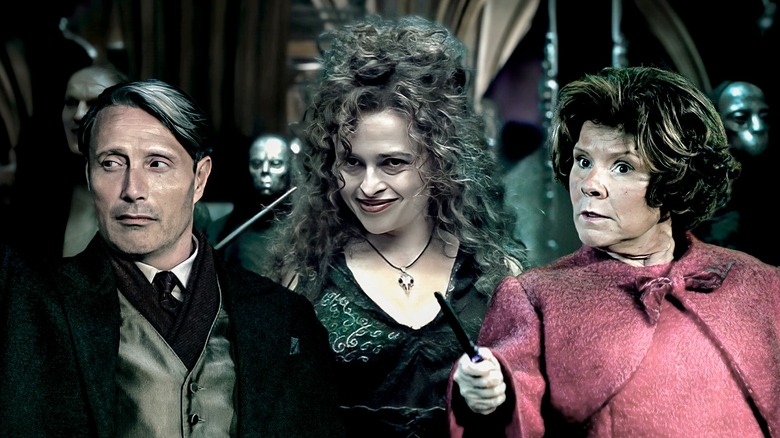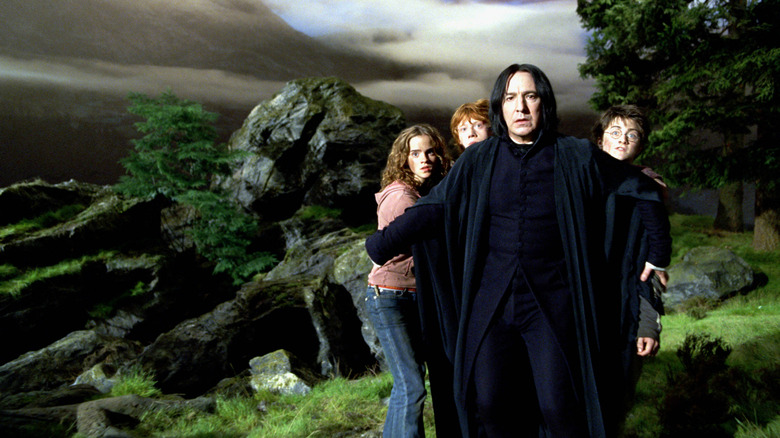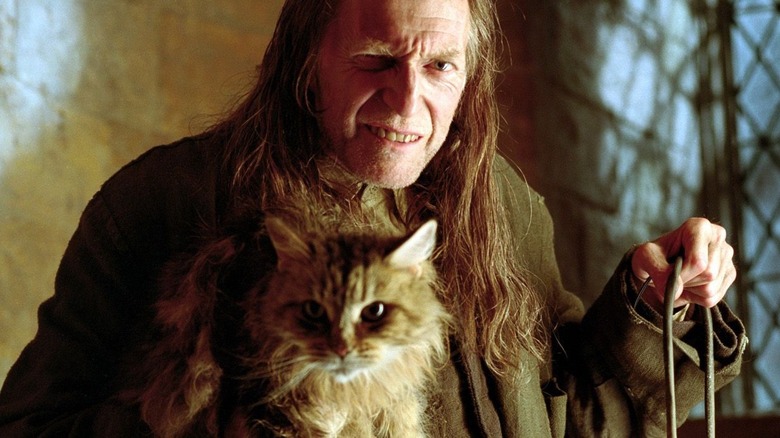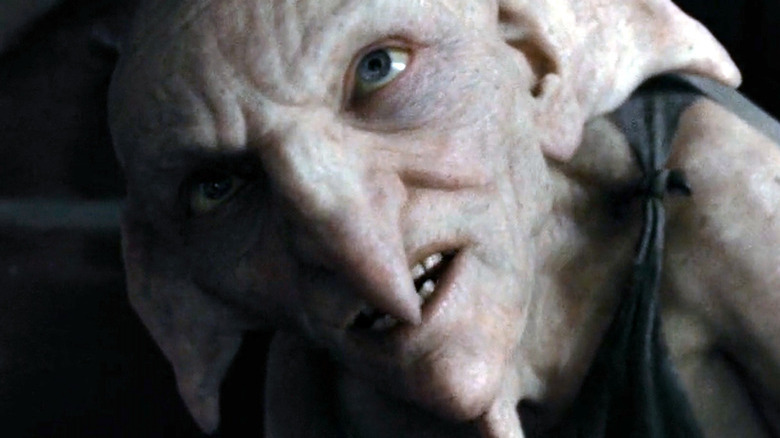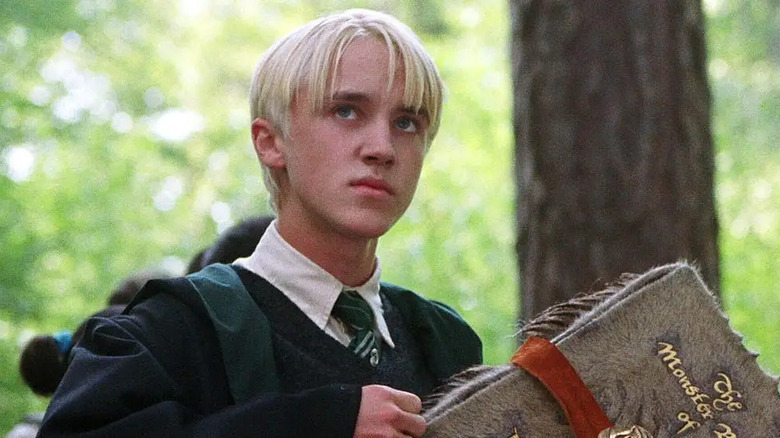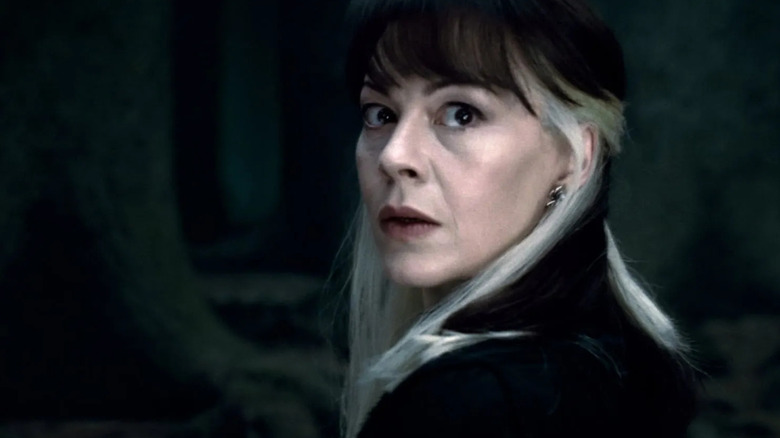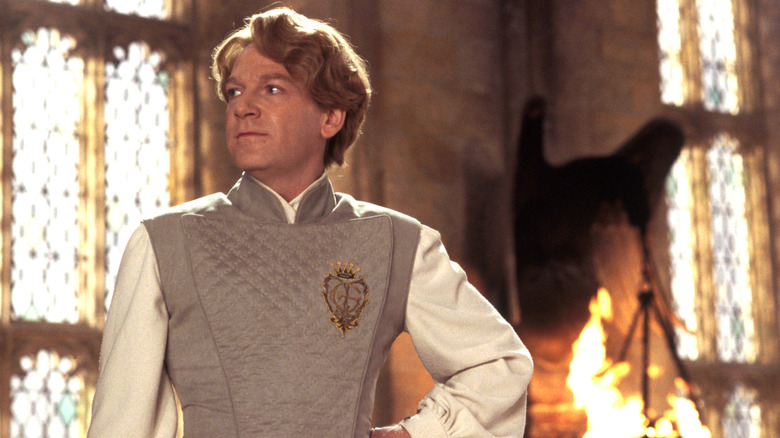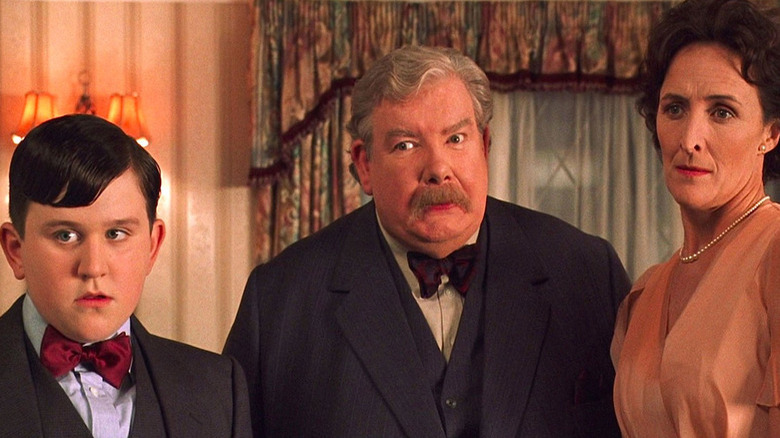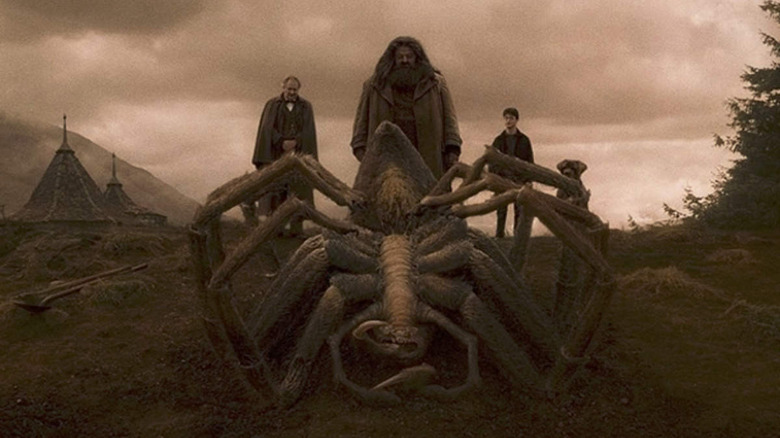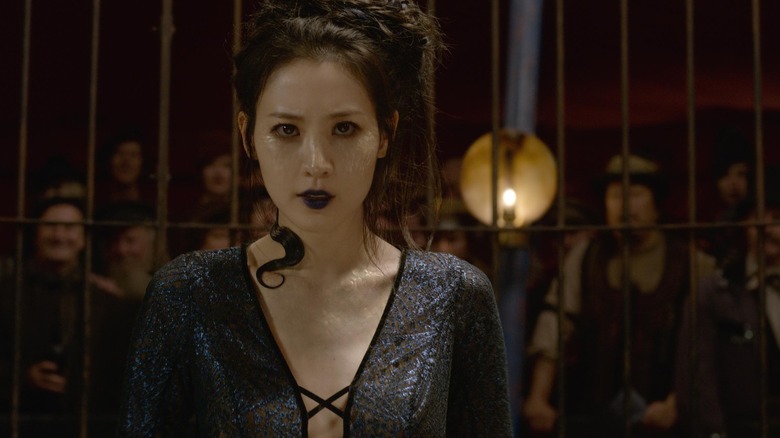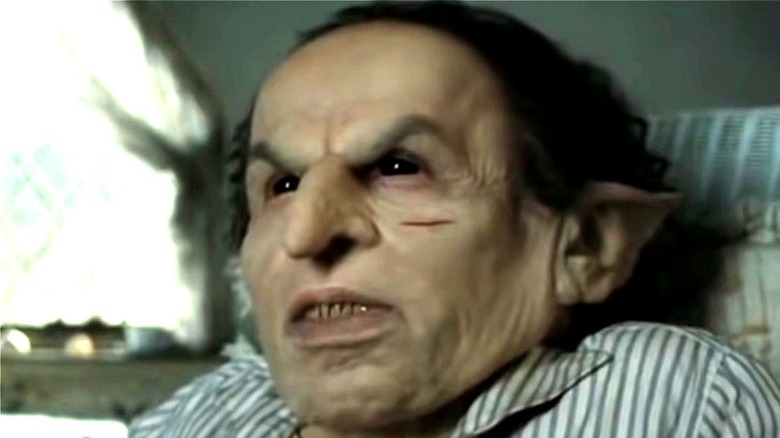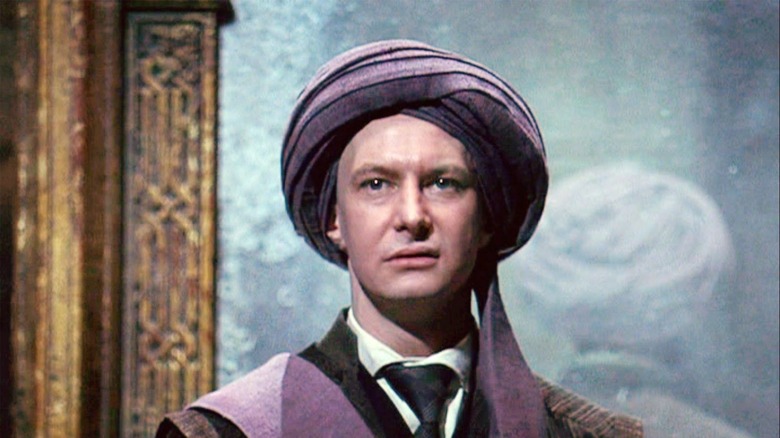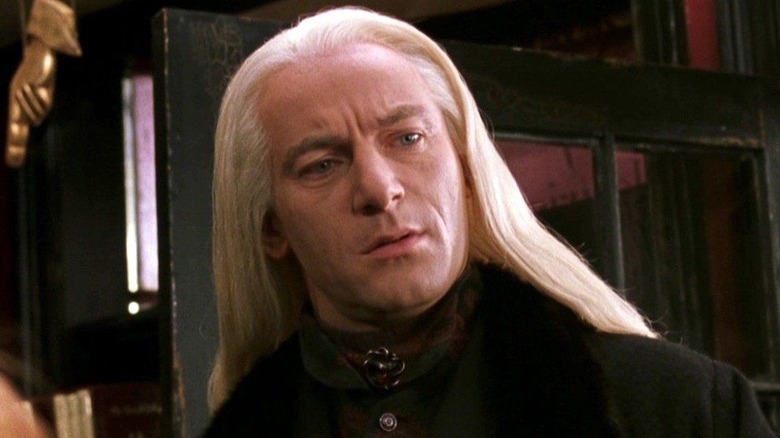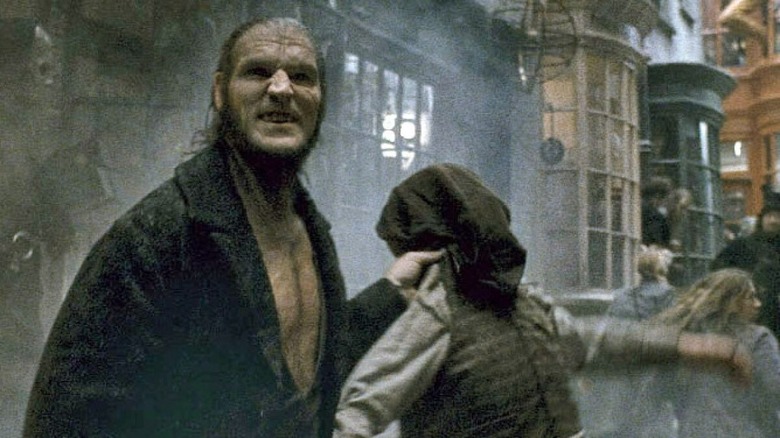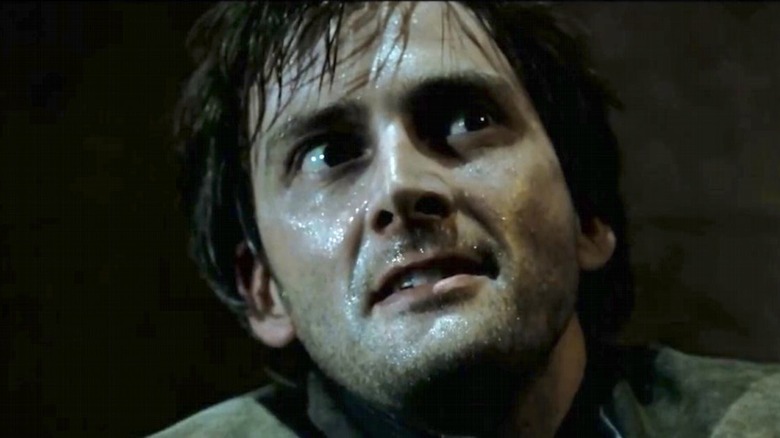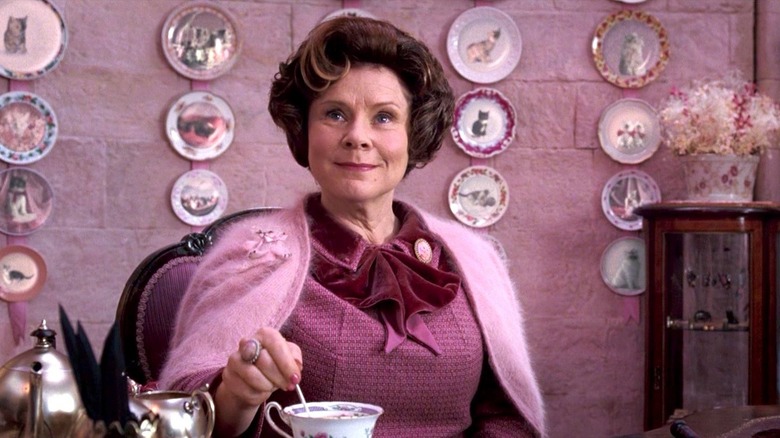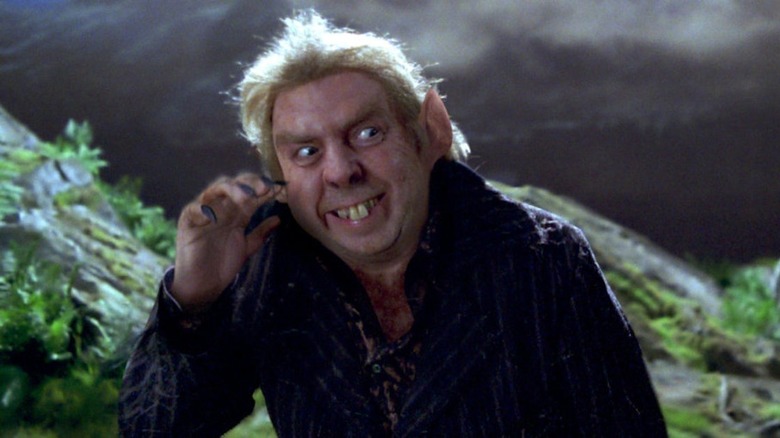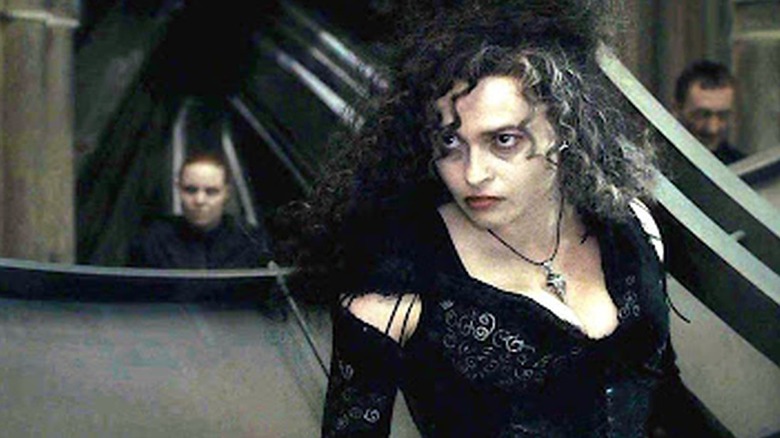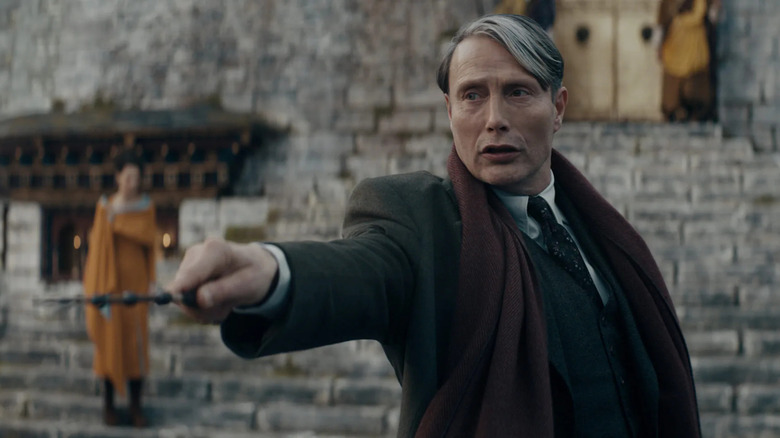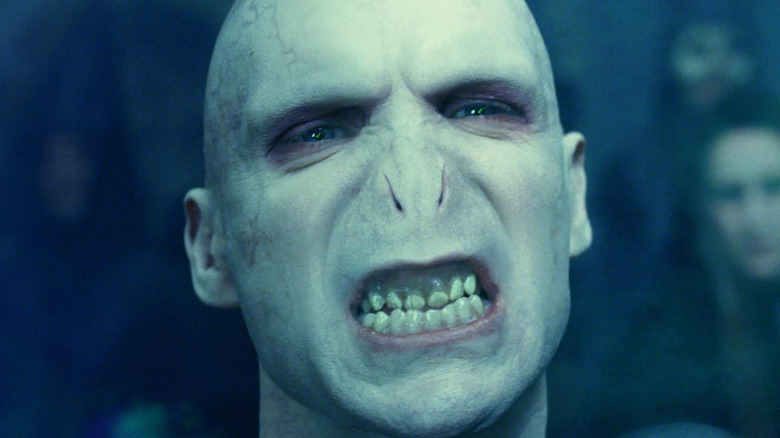Harry Potter: All The Villains Ranked From Bad To Diabolical
The "Harry Potter" franchise has given fans a lot to love. Many Potterheads identify with a particular Hogwarts house. Others see themselves in a favorite character, like Luna Lovegood or Neville Longbottom, and some just enjoy the magical ephemera such as enchanted mirrors and real-working love potions. But among the many lasting things "Harry Potter" has given its readers and viewers throughout seven books, 11 movies, and a stage play is a roster of villains that can match any young adult or fantasy series in the way of their truly evil schemes and ability to deal devastating blows. In fact, the villains in "Harry Potter" are often some of the most compelling characters, and a great deal of the fun — especially the first time through — is trying to figure out who the villain is in the first place.
Some of the Potterverse's antagonists are but bumps in the road to Harry, Ron, and Hermione's eventual victory. Some are misunderstood characters for whom the audience might even have some affection. And some are irredeemable monsters that number among the all-time great (well, terrible) villain pantheon. As Harry and his cohorts make their way through a treacherous seven years at Hogwarts, these are the many baddies they encounter, ranked according to their wickedness.
19. Severus Snape
It's debatable whether or not Professor Severus Snape even counts as a "Harry Potter" villain. Snape ultimately reveals himself to be a tragic hero with a complicated and sympathetic backstory, but since readers and viewers experience him as a villain for at least part of the series' run, we've included him on this list.
Bullied at school, this "half-blood" prince grew up amongst poverty-stricken muggles and fell hard for the one kid who was kind to him: Lily Evans. Lily went on to marry the rakish James Potter, breaking Snape's heart. That heart was broken again when she was killed by Voldemort (who broke his promise to Snape to spare her), leaving behind her infant son, Harry, and setting Snape on an 18-year path of righteous misery. Always the Potions master and never the Defense of the Dark Arts teacher (well, at least not until book six), Snape has to protect and sometimes even mentor Harry, who reminds him both of the woman he loved and the (in his opinion) insufferable man she chose instead of him. That's why he delights in playing the role of the bad guy so convincingly. This sullen Slytherin may have joined the Death Eaters in earnest, but once the loss of Lily compels him to switch sides and join the Order of the Phoenix, he serves as a double agent at great personal risk.
Snape makes two enormous sacrifices as the series barrels toward its conclusion. He upholds his pact with Dumbledore to kill his beloved headmaster, then he loses his own life to Voldemort over some confusion about the possessor of the Elder Wand.
18. Argus Filch
Argus Filch is another ill-tempered character who often gets in Harry, Ron, and Hermione's way, though he isn't a villain in the grand scheme of things across the seven books and eight movies in the main "Harry Potter" series. Filch was born a squib (a non-magical member of a wizarding family) and given a job at Hogwarts School of Witchcraft and Wizardry as a caretaker. His responsibilities perfectly suited his meddlesome personality. Filch wanders the halls at any and all hours of the day and night and is constantly on the lookout for misbehaving students. Like a too-invested hall monitor, Filch seems to take those aspects of his duties much more seriously than actual property maintenance.
There's definitely a sadistic side to this constantly lurking presence, who enjoys catching students in the act and sending them on their way to certain punishment. Perhaps because of his status as a squib, Filch doesn't have much affection for Hogwarts' students. He plays a larger part in the events of "Harry Potter and the Chamber of Secrets" when he grows to distrust them even more when his precious cat and longtime companion, Mrs. Norris, becomes the victim of basilisk petrification. He happily aligns himself with a fellow stickler for the rules, Dolores Umbridge, but when the Second Wizarding War breaks out, Filch ends up on the right side of history. He and Madam Pomfrey evacuate underage students during the Battle of Hogwarts, then, despite his lack of any magical abilities, he stays behind to fight and is injured in the process.
17. Kreacher
The "Harry Potter" franchise makes use of some of the fantasy genre's most recognizable tropes — chief among them is the inclusion of elves. The Wizarding World's elves aren't anything like those from Middle-earth, however. They may still have overly large, pointy ears, but these tiny humanoids are an oppressed class, and individual specimens often present as embittered or pathetic. While fan favorite Dobby falls into the latter category, Kreacher falls into the former. His loyalties and motivations pose a problem for the Order of the Phoenix, who uses the home he cares for as their secret headquarters.
Kreacher was worn down by his long years in service to the Black family, and he picked up several of their unsavory opinions and habits. Many of the Blacks, including Sirius, treated Kreacher cruelly, which he came to reflect in his treatment of others, including Harry. He's blatantly pro-pureblood, he's dishonest and thieving, and he prefers the company of the Malfoys and Lestranges. When a misunderstanding gives Kreacher permission to visit Bellatrix and Narcissa, the jaded house elf blabs about Harry and Sirius, which sets in motion events that get his master killed.
But, as Dumbledore explains, Kreacher is what humans made him. He demonstrates a capacity to love his former mistress Walburga Black, and when Harry, Ron, and Hermione start showing him deference and affection, his whole demeanor changes. By the end of "Harry Potter and the Deathly Hallows," he's leading the elfin charge against Voldemort.
16. Draco Malfoy
Yet another product of trauma, Draco Malfoy starts out as a foil to Harry Potter but evolves into one of the more relatable characters in the series. Though they're almost always pitted against each other, and there's no love lost between them, Harry and Draco have more in common than they might like to admit. Both were born into renowned magical families. Both are ambitious and carry the weight of massive expectations upon their shoulders. And both see themselves as existing outside of the rules that govern everyone else at Hogwarts and in the Wizarding World. The main difference is, Harry's parents remained altruistic and died for it, while Draco's were opportunistic during the First Wizarding War and survived. They were able to raise their son, who absorbed the Malfoy family's twisted convictions.
As a result, Draco is bigoted, classist, and conceited. For most of the series, he's merely a schoolyard tyrant to Harry, Ron, Hermione, and Ginny. But when he becomes an actual Death Eater at 16, he seems to realize that he and his family are in over their heads. Draco's a snob who constantly has to exert dominance in order to feel he has any self-worth, but that's only because his father, Lucius, values power and status more than the people in his life, including his own son. He shows his true colors when he can't bring himself to kill Dumbledore. Draco endured one more emotionally scarring year as a Death Eater out of self-preservation before switching sides at a critical juncture. In his adult life, he became decidedly more open-minded, as well as less hostile (if not quite friendly) toward Harry Potter.
15. Narcissa Malfoy
One of the two people who facilitated Draco's problematic upbringing was his mother, Narcissa Malfoy. A Black by birth and the sister of Bellatrix Lestrange and Andromeda Tonks, Narcissa married Lucius Malfoy, the son of another prominent magical family. Her husband may have espoused fanatical wizarding politics — and it should be noted that Narcissa shared many of those beliefs to some extent — but she never officially joined Voldemort's ranks as a Death Eater. The Malfoys are, above all, traditionalists (likely since those traditions afford them privilege). Narcissa's the type of wife who would support her husband no matter what. As such, her most objectionable trait is her indifference to the suffering of others. More specifically, she's indifferent to the suffering of anyone who isn't Draco.
About halfway through the "Harry Potter" series, it becomes clear that Narcissa's only motivation is the safety and happiness of her son. That's an understandable (if not always admirable) impulse for a mother to have. Narcissa certainly doesn't have progressive views about magical society, but she isn't a violent zealot like her husband. She'll enable the men in her life, whether that means allowing Draco to run roughshod over professors at Hogwarts or turning a blind eye to Lucius' crimes against humanity. But when Voldemort sets his sights on her boy, she begins looking for a way out.
14. Gilderoy Lockheart
In addition to the spirit of Tom Riddle, the antagonist of the second book and film, Gilderoy Lockhart is also the second Defense Against the Dark Arts teacher slash villain in disguise in a row. While the first one was stuttering and sniveling, version 2.0 is a charismatic spotlight seeker who's both intrigued and threatened by Harry Potter's own celebrity. We're told that Lockheart is as handsome as he is heroic. On the page and on the screen, the Wizarding World's women swoon at the sight of him and scramble to the front of the line at his book signings. But this is a case where the audience knows better than the characters. Fans surely suspect something was up with golden boy Lockhart from the very moment his grinning portrait waves back from the cover of his autobiography, "Magical Me."
Of course, Gilderoy Lockhart turns out to be nothing more than a poser who mastered one good memory-wiping charm. Tales of his valor are all stolen from the real heroes who've had their minds' erased. Lockhart's vanity, fragility, and incompetence are cringe-worthy, and it's hard to say anything positive about someone who'd trade children's lives for more acclaim. Still, Lockhart never acts in concert with Voldemort toward any ideologically reprehensible ends. His crimes are all short-sighted and committed in his own self-interest, which is why it's so satisfying when he finally gets his comeuppance. A backfiring wand renders him clueless about who he is and puts him in St. Mungo's where he lives out the rest of his days in obscurity.
13. The Dursleys
Harry Potter begins his hero's journey in about as humble a place as any main character can: living in a cupboard under the stairs in the home of his neglectful aunt and uncle. Being that Harry's an orphan who lost both of his parents before he ever really got to know them, readers and viewers might expect Aunt Petunia and Uncle Vernon to treat the withdrawn 11-year-old with kid gloves. Instead, we're swiftly introduced to a family who's almost too nasty to be believed. There's a glaring double standard in their parenting style. They spoil their biological son, Dudley, to no end while Harry has to make do with hand-me-downs that don't fit. But much worse is the verbal, emotional, psychological, and possibly physical abuse Harry suffers as an unwanted member of the Dursley household.
Uncle Vernon and Aunt Petunia regularly insult Harry as well as his late mother and father. They joke that they almost beat him and almost starve him. In short, they do the bare minimum in honoring their duty to keep Harry safe, and they're so ill-disposed toward magic culture that one gets the sense the Dursleys wouldn't be overly upset if they fail in their mission. Especially in the earlier volumes that target younger audiences, "Harry Potter" represents an exaggerated reality. There's meant to be an element of absurdity to Harry's living situation, but if a child was treated this way in the real world, we can only hope someone would alert the proper authorities.
If you or someone you know may be the victim of child abuse, please contact the Childhelp National Child Abuse Hotline at 1-800-4-A-Child (1-800-422-4453) or contact their live chat services.
12. Aragog
Elves aren't the only creatures "Harry Potter" has in common with Tolkien's Middle-earth. Giant spiders are another fixture of fantasy literature, and one gets introduced into the Wizarding World thanks to animal lover and the keeper of keys and grounds, Rubeus Hagrid. A gentle half-giant himself, Hagrid has an affinity for the sorts of creatures that scare everyone else. He hatched his acromantula, Aragog, while he was a student at Hogwarts and continued to care for him until he grew too big to be kept in the cabinets at school. As groundskeeper, Hagrid could maintain his relationships with beings like Aragog who resided in the Forbidden Forest.
Aragog trusts Hagrid but conceives of all other humans as a potential food source. Thus, when Harry and Ron go to him for information about the heir of Slytherin, the huge spider tells them what they came to hear, but plans to feed the second-year students and best friends to his children immediately thereafter. Aragog gets major villain points for trying to devour two main characters, which he would do without a second thought if the bewitched Ford Anglia doesn't come to the rescue. But Hagrid's one-time pet is only behaving as his species is expected to.
11. Nagini
It's practically become a cliché that villains are characters working through their trauma. In the "Harry Potter" series proper, Nagini is simply Voldemort's snake sidekick who becomes one of his seven life-extending Horcruxes. She isn't verbal or independent-minded like Aragog; she just does the Dark Lord's bidding. Nagini brutally attacks Arthur Weasley and murders Snape, which would place her much higher up on this list of diabolical villains... if not for the "Fantastic Beasts" prequel series and its Nagini redemption arc.
In those films, we find out that Nagini isn't really a snake at all. She's a Maledictus (a person cursed by blood to transform into a beast) who was being exploited by the magical circus in the 1920s. She meets and forms a trauma bond with Credence Barebone, though, for a time, they end up on opposite sides of the conflict between Gellert Grindelwald and Albus Dumbledore. Somewhat surprisingly, Nagini fights against Grindelwald. The future of the "Fantastic Beasts" movies is uncertain, with some reports claiming Warner Bros. has canceled a planned fourth and fifth installment, so we may never get to see how Nagini permanently transforms into a Burmese Python and we may never know why she makes such a hard turn toward evil with Voldemort.
10. Griphook
In addition to magical humans and subservient elves, the Wizard World is also home to goblins. Their portrayal in the Potterverse is somewhat controversial; various cultural critics have observed that J.K. Rowling's goblins come off as anti-Semitic, in both their appearance and motivations. The character Griphook certainly doesn't help. This Gringotts banker is shrewd, calculating, and not to be trusted. Though he purports to be helping Harry, Ron, and Hermione (as well as Voldemort and Bellatrix), he's openly prejudiced against human wizards and is always, first and foremost, looking out for himself.
One of Griphook's defining traits is that he covets the sword of Godric Gryffindor. He's willing to play both sides to end up in possession of the valuable relic. He agrees to help Harry, Ron, and Hermione break into Gringotts and into Bellatrix Lestrange's vault where Helga Hufflepuff's cup (a Horcrux) is kept. But he's willing to go along with the plan not solely because he longs for an end to the war. His price is the sword, which he steals before Harry can use it to destroy the Horcrux. Griphook's betrayal and greed cost him and the other goblins their lives. Voldemort finds out about his duplicity and lays waste to his kind. He dies with the sword of Gryffindor in his hand, only to have it vanish out of his grasp and back into the sorting hat.
9. Quirinus Quirrell
"Harry Potter and the Sorcerer's Stone" first introduces the world to what will become beloved characters and locales, but it also creates the template for future "Harry Potter" mysteries. The books and films might not seem like mysteries on the surface, but inherent to every story is the secret identity of Voldemort's henchman-of-the-school year. In the debut novel — after chapters worth of misdirects that point to Snape — that henchman is revealed to be unassuming Professor Quirinus Quirrell, and Voldemort himself is revealed to be living (if you can call it that) on the back of his purple turban-wrapped head.
Harry Potter's first main antagonist ranks in the middle of this list because poor Quirrell is a vessel for Voldemort's return more than he's a character with any real agency. Meek Quirrell had once imagined that he could gain the Wizarding World's respect by tracking down and apprehending the Dark Lord all by himself. Instead, Voldemort found the Muggle Studies turned Defense Against the Dark Arts teacher while he was on sabbatical and easily bent him to his will, turning his body into a partial, temporary Horcrux. Quirrell does attempt to harm Harry throughout the debut novel (he lets in the troll, and he sabotages Harry's broom) even before the climactic final showdown in which he removes the cloth that conceals what's really on the back of his head. But we can't give Quirrell much credit; he is under the real villain's influence. In fact, Professor Quirrell is himself a victim of Voldemort, as the body they share burns up at Harry's touch thanks to Lily's protective charm.
8. Lucius Malfoy
The Malfoys are the Malfoys because of their patriarch. Lucius isn't just an entitled snob with some unsavory opinions about Muggles, half-bloods, and working-class wizards and witches. Despite his comfort and relatively high status, he's an enterprising social climber with absolutely no moral compass who cherishes his proximity to power above all else.
Like the worst kind of leader, Lucius is transactional and self-preserving. In his own affairs, he uses his many connections as well as those who are indebted to him like a mob boss might. For Voldemort, to whom he was once second-in-command, he's the grunt who carries out the torture and murder. Lucius dislikes Harry and Hermione, but he hates the Weasleys and singles them out for persecution whenever possible. He undermines Arthur at work, and it's he who stashes Tom Riddle's diary with Ginny's schoolbooks.
Though he claims to be a true believer in the Dark Lord and his awful cause, Lucius' loyalty is still fickle. He coerces his contacts at the Ministry of Magic into supporting his story that he was under Voldemort's Imperius Curse after the first uprising, and he turns at the last possible moment after it becomes clear the Death Eaters will lose the second war, too. To top it all off, Lucius is a terrible father who teaches his son to hate and then willingly puts him in harm's way.
7. Fenrir Greyback
Unlike a great many characters on this list, Fenrir Greyback has no tragic backstory to justify his proclivity toward evildoing. He's just a werewolf that loves causing mayhem and inflicting violence, especially as a wannabe member of the Death Eaters (he never officially gets his dark mark). It's Fenrir who infects smart and sensitive Remus Lupin with lycanthropy — the werewolf aspires to spread his condition throughout wizardom until there are more of his kind than not. Thankfully, he never gets that far. But Fenrir still manages to do a considerable amount of damage in his limited appearances in the "Harry Potter" franchise.
While Fenrir Greyback has few if any redeeming qualities, the absolute worst thing about him is his implied preference for biting children. Viewers can interpret that however sordidly and metaphorically they wish. He has a record of killing kids in his beastly form that goes back to at least 1965, and during the events of the "Harry Potter" series, he kills a five-year-old boy, gravely injures Bill Weasley, and murders Lavender Brown. He's subdued by Hermione Granger, Professor Trelawney, Ron Weasley, and Neville Longbottom shortly thereafter. The sinister Fenrir Greyback ranks here only because he doesn't get more page or screen time and he never quite reaches his full, horrific villain potential.
6. Barty Crouch Jr.
The "Harry Potter" books and movies get progressively more mature in their content as their protagonists age from tweens to young adults. The middle volume, "Harry Potter and the Goblet of Fire," is a turning point. New Defense Against the Dark Arts teacher, Mad-Eye Moody (who's coded as an ornery alcoholic), is a prime candidate for secret villainy throughout book and movie four. But in one of the series' more confusing plot twists, Alastor Moody is revealed to be Barty Crouch Jr. — son of high-ranking Ministry of Magic official Barty Crouch — roleplaying as Mad-Eye thanks to an ample supply of Polyjuice Potion (meanwhile, the real Mad-Eye is locked away in his magical chest).
Barty Crouch Jr. is among the most dangerous of all "Harry Potter" villains. Before we meet him in person, he has already enthusiastically joined the Dark Lord's ranks and committed countless heinous crimes — perhaps the worst of which is the Cruciatus Curse he used on Neville Longbottom's parents, which resulted in their incurable insanity. He has been sentenced to life in prison at Azkaban (a ruling handed down by his own father) but becomes one of the only inmates ever to escape with the help of his co-conspirator's parents. That's when Barty Crouch Junior returns to Voldemort's side and begins posing as Hogwarts' newest teacher. Barty uses the Tri-Wizard Tournament to arrange for the Dark Lord's return. He's a troubled soul who would rate higher if wasn't undercover for most of his mission.
If you or anyone you know needs help with addiction issues, help is available. Visit the Substance Abuse and Mental Health Services Administration website or contact SAMHSA's National Helpline at 1-800-662-HELP (4357).
5. Dolores Umbridge
Perhaps no "Harry Potter" character is more reviled than Dolores Umbridge, a senior undersecretary to three Ministers of Magic and temporary appointment to Hogwarts as — you guessed it — Defense Against the Dark Arts teacher. While the majority of "Harry Potter" villains (or red herrings) look disheveled and behave erratically, what's so distressing about Dolores Umbridge is how seemingly normal, calm, and put-together she is. Her outfits and her office are awash in twee pink, with never so much as a hair or a thread out of place. She never raises her voice because she doesn't have to; Umbridge is bureaucratic authority personified. It's just that she uses the polite trappings of law and order to rule with a bejeweled iron fist.
Dolores Umbridge upsets the balance of power as soon as she arrives at Hogwarts. She concocts schemes to have Professor Trelawney and Hagrid removed from their posts and eventually displaces Dumbledore as Headmaster. She establishes impossibly strict rules for Hogwarts' students as inquisitor, and she thrills at the opportunity to punish wayward kids with her torture quill, which inscribes written words onto the writer's skin. This sugar-coated fascist is, like most fascists, a total hypocrite who'll bend the rules as a means to her own ends. She's willing to hand teenage Harry over to the Dementors, but as frustrating and detestable as she is, her actual acts of malice don't compare to the series' other top-tier villains.
4. Peter Pettigrew
Audiences first meet Ron's pet rat Scabbers in "Harry Potter and the Sorcerer's Stone." But then "Harry Potter and the Prisoner of Azkaban" contains the surprise revelation that the scraggly rodent who's prone to biting his master is none other than Peter Pettigrew, the one-time member of the Marauders (along with James Potter, Remus Lupin, and Sirius Black). Peter was presumed dead after a Muggle attack for which Sirius Black was blamed. The truth is, though, Peter framed his friend to take the fall not only for his faked death and the 12 Muggle murders but also for the betrayal of James and Lily Potter. An animagus, he went into hiding as Scabbers until the Dark Lord re-emerges and needs his help again.
That Peter Pettigrew ratted out his friends and robbed Harry of his parents is despicable, but that he spent years as a child's pet without that child knowing is just plain gross. Though he registers as a sidekick and doesn't seem to have ambition on par with, say, Lucius Malfoy or Dolores Umbridge, Peter is one of the Dark Lord's most unwavering devotees (until a moment of hesitation costs him his life), and he's the driving force behind some of the worst developments in the plot of the "Harry Potter" series. He's instrumental in bringing about Voldemort's return to human (well, human-ish) form, and it's he who uses the killing curse on Cedric Diggory.
3. Bellatrix Lestrange
"Harry Potter" fans are told of the evil exploits of two dark, magical, would-be dictators throughout the books, movies, and plays that cover the story in its entirety. But when it comes to the villainy that we actually experience within that story, nobody inspires more fright than Bellatrix Lestrange. The woman who rises to become Voldemort's right-hand witch (not to mention his lover and the mother of his child, Delphini) is like a walking, wand-waving combination of the worst parts of every "Harry Potter" antagonist. She's as ideologically rigid as Gellert Grindelwald, as laser-focused and relentless as Lord Voldemort, as bloodthirsty as Fenrir Greyback, as fanatical as Barty Crouch Jr., as ghoulish as Peter Pettigrew, and as loathsome as Dolores Umbridge. And she looks so cool being so evil, many Potter fans love her in spite of it all... which is the ultimate trick that a villain can pull.
The case for Bellatrix's supreme villainy is simple: She's singlehandedly responsible for some of the franchise's most devastating deaths, and some of her victims are her own blood relations. She kills her cousin Sirius Black when she sends him flying through the veiled arch during their duel in the Department of Mysteries. She kills Dobby when her knife lands in his chest just as he's about to make his escape (she really has a thing for committing murder via portals). And she kills her own niece Nymphadora Tonks at the Battle of Hogwarts. Bellatrix may be the final boss of either "Harry Potter" series, but she's probably the most ruthlessly skilled character that Potter fans ever see in action.
2. Gellert Grindelwald
The "Harry Potter" saga has been seen as an allegory about the fight against injustice since it hit bookshelves back in 1997. Many fans have picked up on what seem like clear parallels between the rise of bigotry-based authoritarianism in our own world history (particularly, the events of World War II and the Holocaust) and in the Wizarding World. With terms like "mud blood" being thrown around and with characters who openly advocate for the genocide of non-magical people, it's easy to see why. Those allusions are pretty vague, however, in the original series of seven books. A much neater comparison for history's most loathsome figures is mentioned on occasion throughout those books, but he's really given his time to show his menace in the "Fantastic Beasts" prequel films.
Gellert Grindelwald is a talented magic wielder who showed signs of turning rotten early on. He has visions of his ascension to power and systematically works both within and outside of the law to coalesce support for his central grievance: that Wizards shouldn't have to exist in the shadows, beholden to Muggles. The lore holds that after he killed the Elder Wand's owner and took possession of it, he went on to slaughter people en masse as well as murder more specific targets. But what's most dangerous about Gellert Grindelwald are his powers of persuasion. He is able to convince witches and wizards to join his movement with speeches, the language and tone of which mirror the deadliest instances of racism in history, including the rise of Adolf Hitler. Grindelwald comes in at number two only because — despite his vast villainous feats — his movies don't do him justice and he's somewhat humanized by his romantic relationship with Albus Dumbledore.
1. Voldemort
Just as Harry Potter is now counted among popular culture's best "chosen one" heroes alongside the likes of Luke Skywalker and Frodo Baggins, Voldemort will forever be mentioned along with pop culture's most notorious villains. The big bad of the entire franchise is an icon even though he assumes multiple forms throughout the seven books and eight movies. As Tom Riddle, he's disarmingly charming. As the face on the back of Professor Quirrell's head, he's bizarre and revolting. And in his revived semi-human state, with his pale, vein-riddled skin and his snake-like slitted nose, Voldemort is the very face of evil.
Though he's clearly an inspiration to the second would-be magical dictator, Voldemort doesn't have the patience for Grindelwald's systematic rise to power. He just grabs it when and where he can, leaving destruction in his wake. Voldemort revels in the trappings of evil in a way that Grindelwald never did. If he gets his way, the world he rules over won't be one in which magical beings live freely at the expense of Muggles; it will be a darkly magical world in which everyone will have to bow before him or risk his vengeance.
Voldemort isn't directly to blame for the majority of "Harry Potter" character deaths, but almost every killer is either carrying out his orders or attempting to curry favor with the Dark Lord. His single-minded obsession with Harry Potter — a child — is intensely creepy. And it's his act that sets the whole "Harry Potter" story into motion when he simultaneously scars and orphans Harry by murdering his parents.
